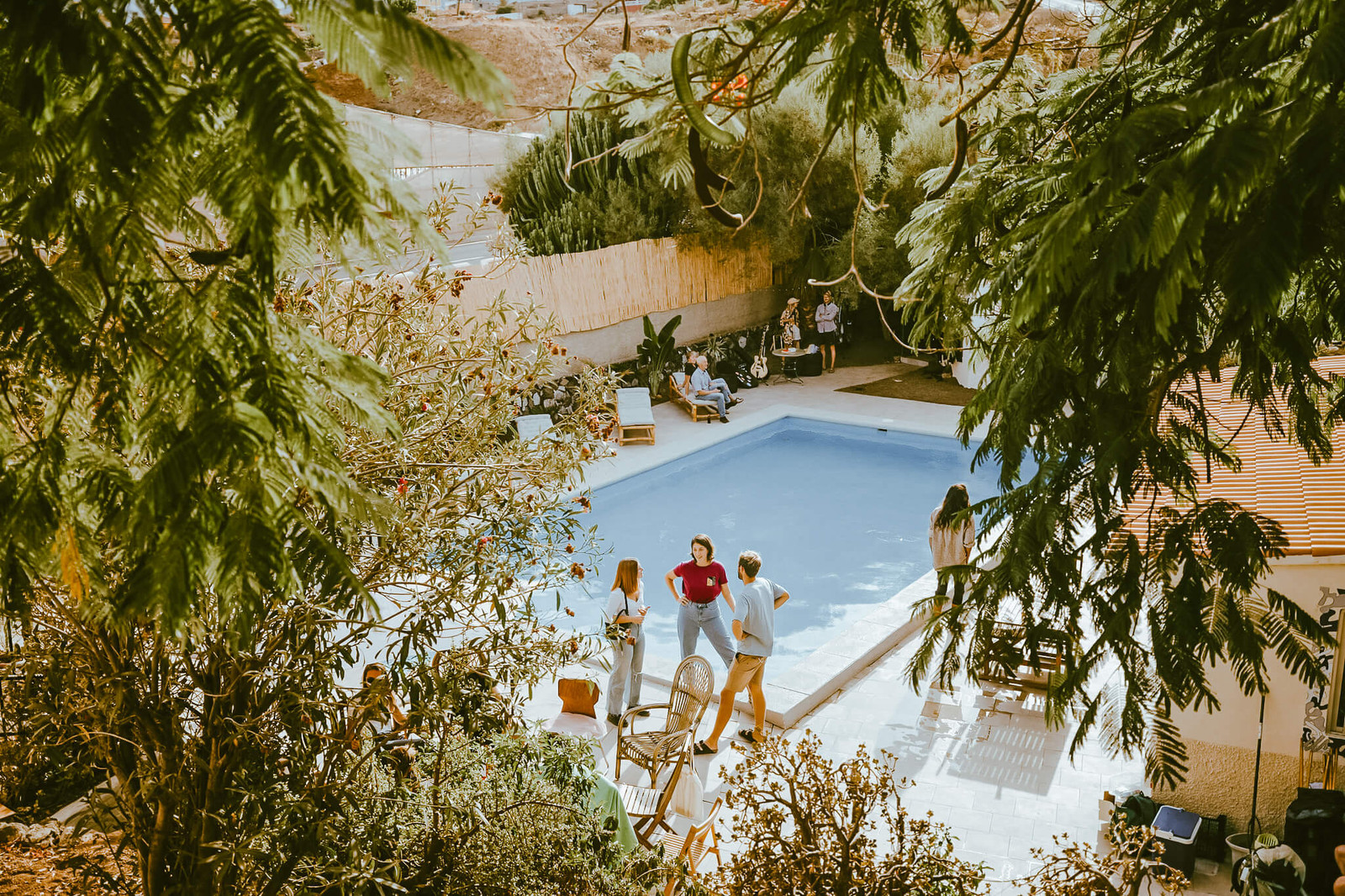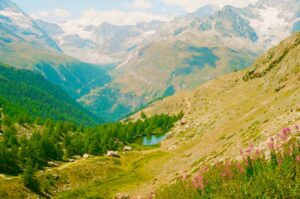From bustling cities like Barcelona and Madrid to tranquil coastal towns and mountain retreats, there are a diverse array of options of coliving in Spain for digital nomads that cater to every taste and lifestyle preference.
Whether you’re seeking the camaraderie of like-minded individuals, inspiration from fellow creatives, or an easy way to book on a room on your nomadic journey, coliving in Spain offers the perfect blend of community, adventure, and cultural immersion.
All of the coliving locations on this list cater to digital nomad professionals who have the intention of getting work done while also seeking a more connected and balanced way of living. For this reason, they tend to draw entrepreneurs, freelancers, artists, and many people within the 30-40’s range. They have lots of fun—and they also get stuff done.
While some of these colives take the private flat route in accommodation, most of them have the intention of fostering meaningful connections and collaboration to provide a supportive environment for both remote work and personal growth. This might mean shared spaces, high-speed internet in the coworking spaces (and beyond), and group activities like dinners, cultural immersion, and overnight getaways.
The following are some of the intriguing and beautiful options for digital nomads coliving in Spain.
1. Finca La Palmera—Costa de la Luz
Finca La Palmera is an eco-living non-profit in the town of La Zarzuela on the Costa de la Luz. The coliving property is centered around a 200-year-old former farmhouse and has all the charm of a boutique hotel, which makes it a beautiful choice for coliving in Spain.
The 6 rooms on the property are newer builds, each with a private bathroom and private garden entrance. Guests can come together in shared spaces like the communal kitchen, living room, and chill-out room.
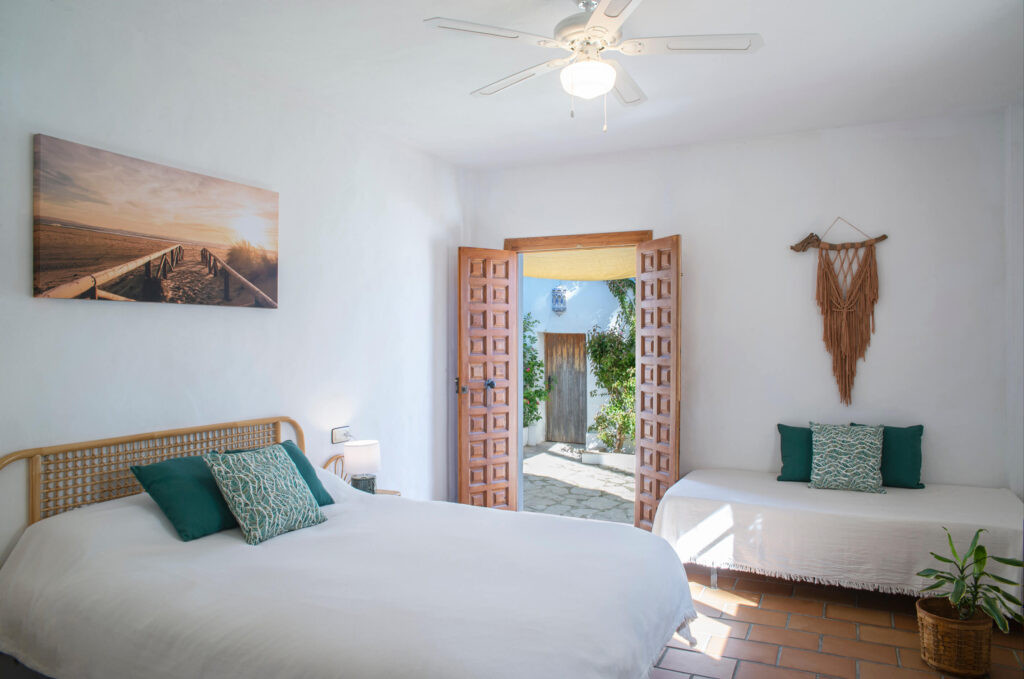
Photo via Finca La Palmera
The property is also prime for outdoor experiences, with a yoga platform surrounded by pine trees, an on-site garden, and a vegetable patch. Nearby are three national parks, and the beach is technically walkable at 4km/2.5 miles away. The hosts also put together activities locally and even do day trips to destinations like Morocco. (It’s just a ferry ride away!)
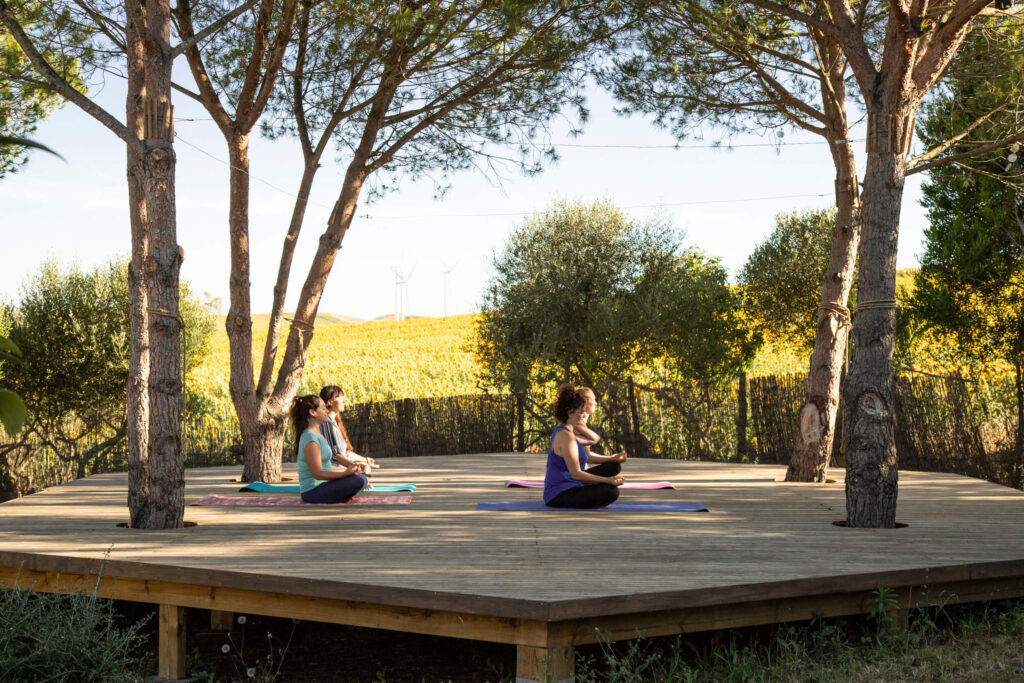
Photo via Finca La Palmera
As for coworking, the property has a large wooden table that’s used as a coworking space, plus lots of other seating throughout the property.
Getting there: The house is located in a rural village called Tarifa—which means renting a car is the suggested way to travel between there and the airport. There are technically busses that go much of the way, but they don’t go all the way to Finca. The closest airports to fly into would be Jerez de la Frontera, Gibraltar, Sevilla, or Málaga.
Minimum stay: One month (although they recommend 2-3!)
Internet Wifi speed: 100/80 Mbps (download/upload)—Fiber line internet with routers throughout the property.
2. Kalart in Montseny Natural Park—Montseny Valley
Kalart is a rural farmhouse located in the Montseny Valley, just outside of the Montseny Natural Park. There are 14 rooms on the coliving property, plus shared spaces including the coworking space, two kitchens, a solarium, and a multi-purpose room. Outside you’ll find terraces, patios, and a vegetable garden.
Each private bedroom has a desk, while the communal coworking space has room for 8.
The property is less than half a mile from restaurants, cafes, and groceries, and each house guest takes a turn preparing lunch for the group. Other activities that colivers can look forward to may include art therapy, dinners out, and masterminds.
The coliving accepts applications to ensure its guests are on the same page—which generally means 30-45-year-old digital nomads/remote entrepreneurs and creatives who live purposefully in all ways.
Getting there: While Kalart is in a rather rural location, it’s also only 50 minutes from Barcelona and Girona. You can get there from Barcelona on the Renfe R2 train.
Minimum stay: One month. Stays can be extended with a one-month notice.
Internet Wifi Speed: High speed.
3. Nomadico/Rooral—Malaga
Nomadico has partnered with Rooral to create this coliving home located in the mountain town of Benarrabá, Spain, home to only 350 people. Staying there not only offers a unique experience of integrating with the Andalusian locals, but also brings sustainability to smaller towns that are shrinking over time.
The coworking space is in a separate building located very close to the house. It has three floors of both indoor and outdoor areas, (with great views), a cafeteria, and more than 20 different dedicated workspaces.
The town itself contains three restaurants, two markets, two butcheries, and a pharmacy. Organized activities for colivers include forest hikes, making cheese, art therapy, yoga, and attending seasonal festivals.
Getting there: The closest airports to Nomadico would be Gibraltar (1 hour and 10 mins away), or Malaga International Airport (1 hour and 30 mins away.)
Minimum stay: 1 week.
Internet: 1GB symmetric speed internet is available in the dedicated coworking space. The house itself does not have wifi in the living areas or rooms, but they do have SIM cards on hand should you need one. (Or better yet, connect to your own eSIM.)
4. Sun and Co. in Javea—Valencia
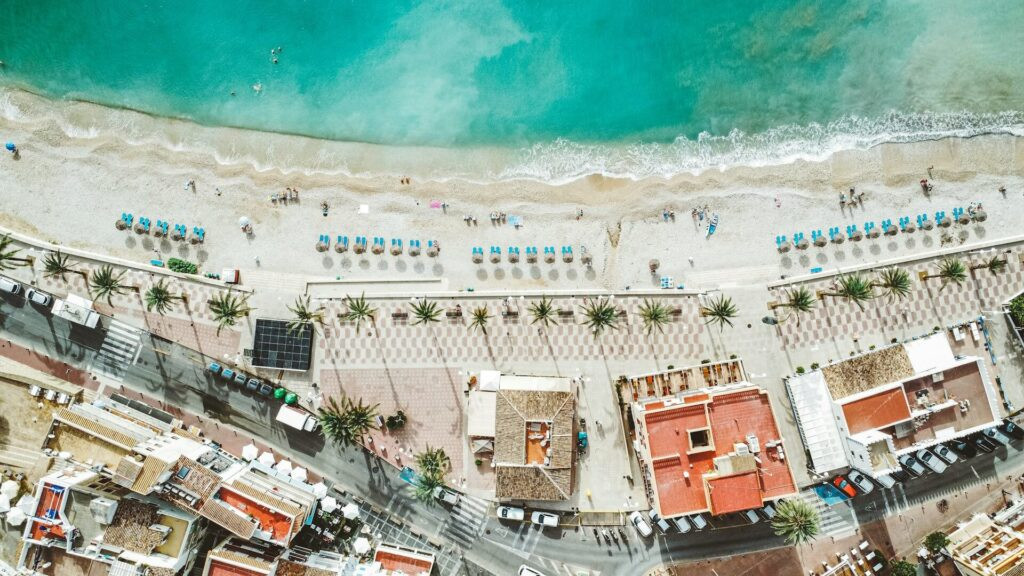
Sun and Co. has been around since 2015 and is one of the pioneers of the coliving space. The property is located in the historical old town of Javea, which is a coastal town in eastern Spain.
They offer both private and shared bedrooms, which have shared spaces like a kitchen, living room, and patio. The coworking space is in a separate location nearby and offers 24/7 access to work at any time. While access comes with a stay at Sun and Co., it’s also possible to purchase a coworking pass if you happen to be staying elsewear in Javea.
The social events at this colive may include hiking, cooking, and dancing. As they’re also big on professional growth, guests can attend three professional events hosted each week. Sun and Co. also host the occasional pop-up retreat, such as a two to four-week stay in a house in Basque country.
One out of every five guests at Sun and Co. end up returning to stay again (and usually within the same year), making this is a popular option of coliving in Spain for digital nomads.
Getting there: The closest airports are Valencia and Alicante. From there, you can get to Javea by bus, shuttle, or car.
Minimum stay: 10 nights.
Internet: High-speed wifi.
5. Sende in Lobeira—Galicia
Sende is located in a tiny village in the town of Lobeira, Galicia Spain—and more than 4000 people from over 60 countries have stayed in the village. Since 2013 they’ve been hosting educators, social entrepreneurs, creatives, and innovators who want a space to work and enjoy life.
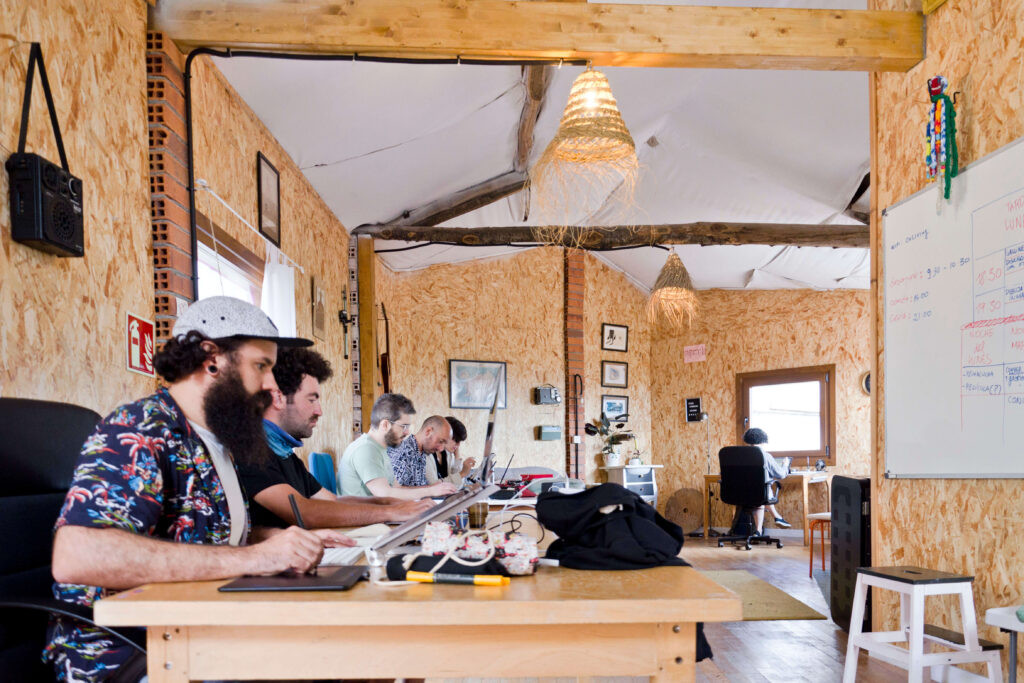
Photo via Sende
In addition to the average digital nomad stay, Sende also hosts specific retreats, like those for concentrated project writing. All of the work and writing can be done within the dedicated coworking spaces.
Colivers join together at the end of the day for a long dinner, which may be held at a long outdoor table in the yard. All of the food is cooked on location from ingredients that come from local gardens and markets. Sende emphasizes living well, with suggestions like getting nine hours of sleep while you’re there. Other activities might include hanging out at natural swimming holes, camping on the nearby Portuguese coast, or visiting Spanish islands.
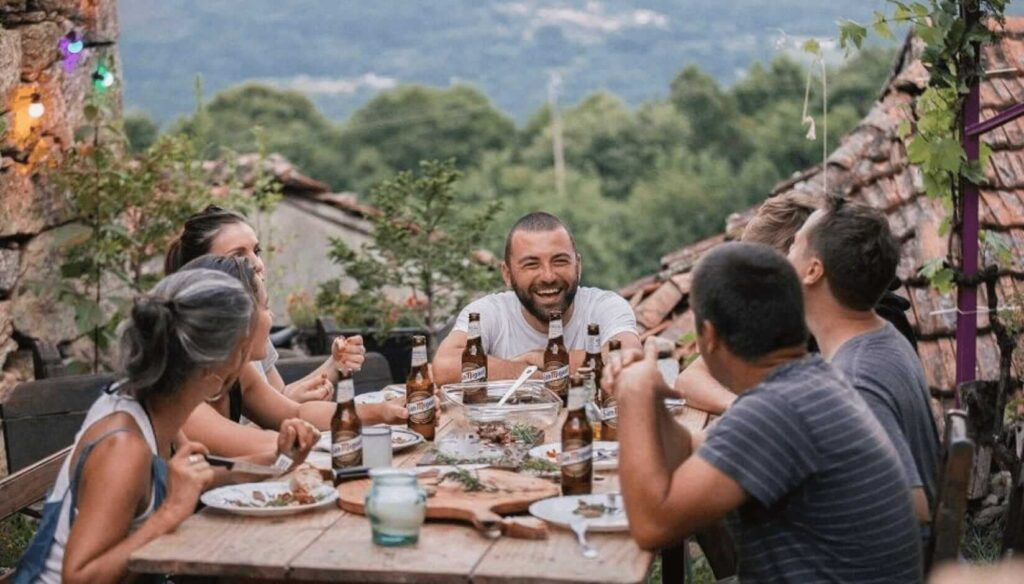
Photo via Sende
Getting there: The closest airports are located in Porto, Vigo, and Santiago de Compostela.
Minimum stay: One-week minimum, one-month maximum. The private rooms are reserved for those who book a full month.
Internet: Average speeds of 160Mbps download and 180Mbps upload.
6. Maraya Coliving—Candelaria, Tenerife North
Maraya is a coliving and coworking property for digital nomads in Candelaria Tenerife. The property has a beautiful pool and is close to the beach—making this one an ideal getaway for adventurous sunseekers.
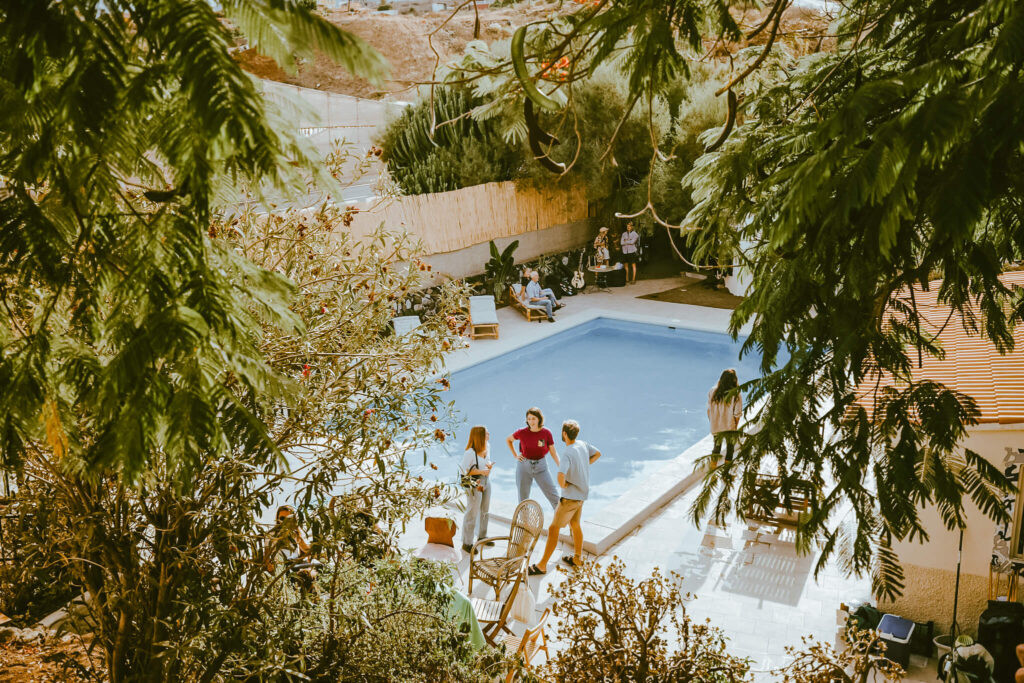
Photo via Maraya Coliving
Each of the nine private bedrooms on the property has its own desk. There’s also a dedicated office space for coworking, a shared kitchen, and a lounge area in the house. Outside you’ll find space for yoga and workouts, a veggie garden, a roof terrace, a ping-pong table, an outdoor cinema, and a bonfire, among other things.

Photo via Maraya Coliving
When you book a room at Maraya you also get daily yoga classes, breakfasts, and four dinners a week. Residents have the option to take part in skillshares—which can range from business-related things to skateboaring—and they also put on events like art exhibitions.

Photo via Maraya Coliving
Getting there: Maraya offers a (paid) pick-up service from either airport in Tenerife. You can also catch a bus at the airport and then take a cab the rest of the way, take a cab the entire way, or rent a car and drive. If you arrive by boat you can catch a cab or take a cab to a bus stop.
Minimum stay: The minimum stay is three nights but most people stay one or two months!
Internet: 500mb download, 500mb upload.
7. RePeople Co-Living—Gran Canaria Canary Islands
RePeople Co-Living has multiple coliving properties in the Canary Islands, located in Las Palmas de Gran Canaria, Santa Cruz de Tenerife, and a fishing village called Agaete. Their homes range from hosting 8 to 62 people at a time and offer both private and shared accommodations.
The shared spaces at RePeople homes include communal kitchens, living rooms, outdoor areas, and workspaces. Their dedicated coworking spaces are in nearby locations with 24/7 access, and most of the rooms have private desks as well.
The colive for digital nomads also offers group activities like surf lessons, hikes, and yoga classes. One other perk: free laundry. They provide free detergent, a washer, a dryer, and an outdoor space to dry clothes as well.
Getting there: Most of the RePeople locations are within 1km/.62 miles from one another. Options include flying into one of the Tenerife airports (there are two) and then going from there.
Minimum stay: One week. Longer stays get discounted rates.
Internet: High-speed fiber optic connectivity at 600/600Mbs.
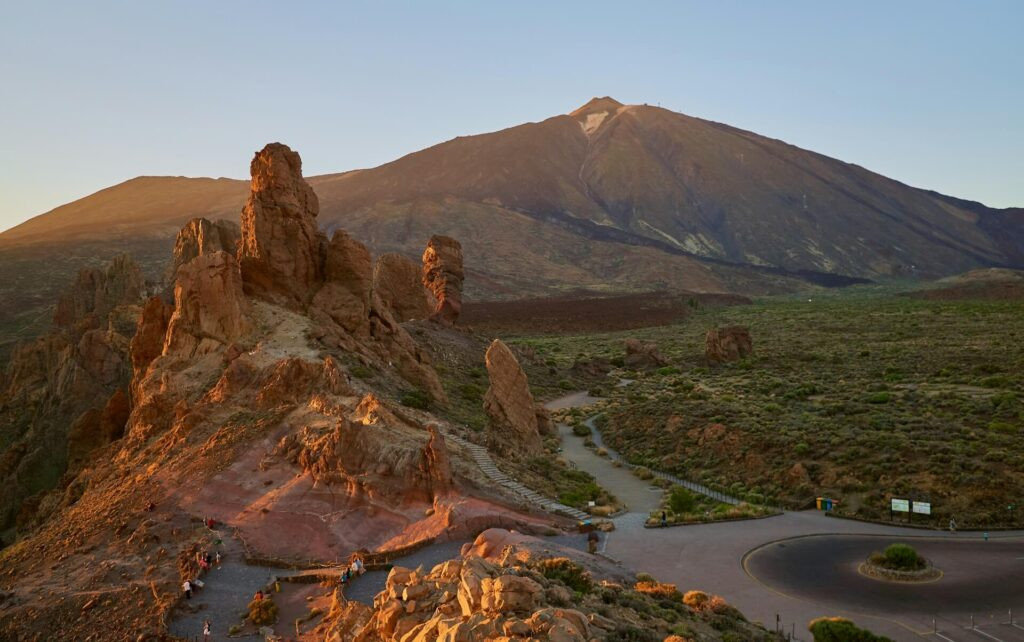
Tenerife by Joshua Humpfer
8. Nine Coliving in Tenerife—Canary Islands
Nine Coliving is located in the historical center of La Orotava, Tenerife where it has views of the sea and El Teide volcano.
The building itself was built in 1852 and guests can choose from single rooms, double rooms, or dorm rooms where there may be up to four people bunking at a time.
There are two 24/7 coworking spaces within the building, a main quiet with beautiful views, and a social one where guests can take calls or meetings. There are also desks within every bedroom, and good wifi all around. It’s also possible to work on the roof, patio, and in the garden, making this one an easy choice for digital nomads in Spain.
Community is a priority at Nine Coliving, so group meals are always an option with daily breakfast, the occasional community lunches, and family dinners. Guests also have access to a kitchen on the property and nearby markets and cafes.
There are regularly hosted yoga and workouts, which take place on the roof of the building with those beautiful sea views.
Getting there: Tenerife has both a North and a South Aiport, and Nine Coliving is closest to North. From there you can take a taxi, a bus, or even rent a car for your stay. (There is street parking.)
Minimum stay: The minimum stay is 14 nights and discounts apply for longer stays.
Internet: There is high-speed internet on the entire property.
9. Amarilla—Tenerife Canary Islands
Amarilla is a coliving community for digital nomads in Spain with locations in both North and South Tenerife, with accommodations including both apartments and homes. They host individual nomads and location-independent business owners, plus offer group retreats.
Their southern locations include a modern home called Casa Marina and a classic villa called Finca Atoga. In the north is the Tulia Community Guesthouse, which is up next on the list.
Their 24/7 coworking spaces at Amarilla locations are available for all residents. Other visitors to the area can also get passes to some of the coworking space, whether they’re staying at Amarilla or not.
Each of the properties has a pool among other amenities. Additional activities include yoga, surf school, hiking, or really anything else that you’d like to do. Amarilla can help arrange adventures like boat trips, jetskiing, and more.
Getting there: The closest airport is the South Tenerife airport. From there, rent a car, take a cab, or look into the local bus route.
Minimum stay: Varies by type of accommodation.
Internet: Fiber-optic internet.
10. Tulia Guest House—Tenerife
While Tulia Guest House is technically a part of the Amarilla family, it has a separate website and vibe. This gorgeous property in North Tenerife is a 17th-century property with both private and shared apartments.
There are kitchenettes within every apartment as well as a community kitchen. Other shared spaces include a pool, rooftop, terrace, garden, library, and coworking spaces.
It’s worth noting that Trulia is potentially booked out for part of the year for retreats. The Community Guesthouse (that anyone can book) is open from March 1st until June 16th and from October 14th until the end of the year.
Getting there: After flying into the North Tenerife airport you can rent a car, catch a taxi, or take a bus to the area.
Minimum stay: The minimum stay in the Community House is one week, and the minimum stay in the Guest House is two nights. There are discounts for weekly and monthly stays.
Internet: High-speed internet.
11. Cactus Coliving—Tenerife
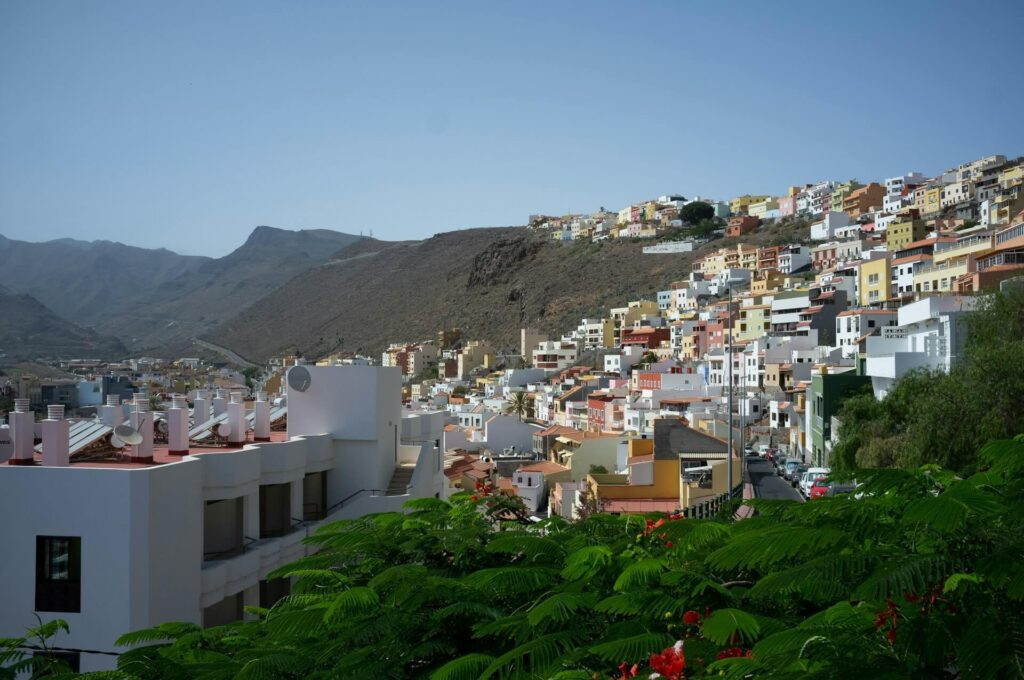
Cactus coliving has homes on both the islands of Tenerife & La Gomera.
Their Tenerife property has 11 bedrooms with both private and shared options, so up to 26 people may be staying there at any given time. The property has two kitchens, nine bathrooms, and a rooftop space for yoga and hanging out. There are two main coworking spaces as well as two conference rooms where guests can take meetings or calls.
The San Sebastian de La Gomera property also has both shared and private rooms with private desks. The property is located in the historical town center and only a six-minute walk to the beach.
Getting there: There are two different ways to get to La Gomera. If you fly into South Tenerife you can take a ferry to the small island. When flying into Gran Canaria or North Tenerife Airport, you can catch a direct flight between the islands. If you fly into the airport in La Gomera a bus can take you to San Sebastian de La Gomera.
Minimum stay: The minimum stay is 7 days with discounts available for longer stays.
Internet: High-speed internet.
12. Awid Aman—La Palma, Canary Islands
Awid Aman hosts digital nomads in Spain for a “blend professional growth with personal fulfillment.” Their colive in located in the city of Los Llanos de Aridane on the northwestern Canary island of San Miguel de La Palma.
The property if close to the beach, mountains, and great for activities like hiking. They encourage conscious living, which might include practicing yoga or meditation, eating locally, forming authentic relationships, spending time in nature, and forming new healthy habits.
This community hosts month long stays as well as offers an option to join their collective. Prospective colivers can book a call to see if they’re the right fit.
Getting there: You can arrive on La Palma via plane or boat, from the mainland Spain or nearby Tenerife.
Minimum stay: TBD
Internet: TBD
13. Coliving 1907—Las Palmas Gran Canaria
Coliving 1907 is located in a coliving property that has been classified as Historial Heritage of the Canary Islands. The Las Palmas home was built in 1907 (hence the name), and is located right in the historic center of town.
Some of the eight bedrooms look out onto pedestrain walkways from their private balconies or windows. There are both single and double rooms on the property, some with ensuites and other with shared bathrooms. Each of the rooms has a desk for private working space, while wifi reaches throughout to other coworking areas like a table on the roof.
Other shared common areas include the kitchen, living room, and courtyard.
Getting there: It’s possible to fly directly to Las Palmas Gran Canaria, as well as take a ferry from mainland Spain or nearby islands.
Minimum stay: 10 nights.
Internet: 1Gb fiber-optic high-speed internet.
14. Urban Campus—Madrid
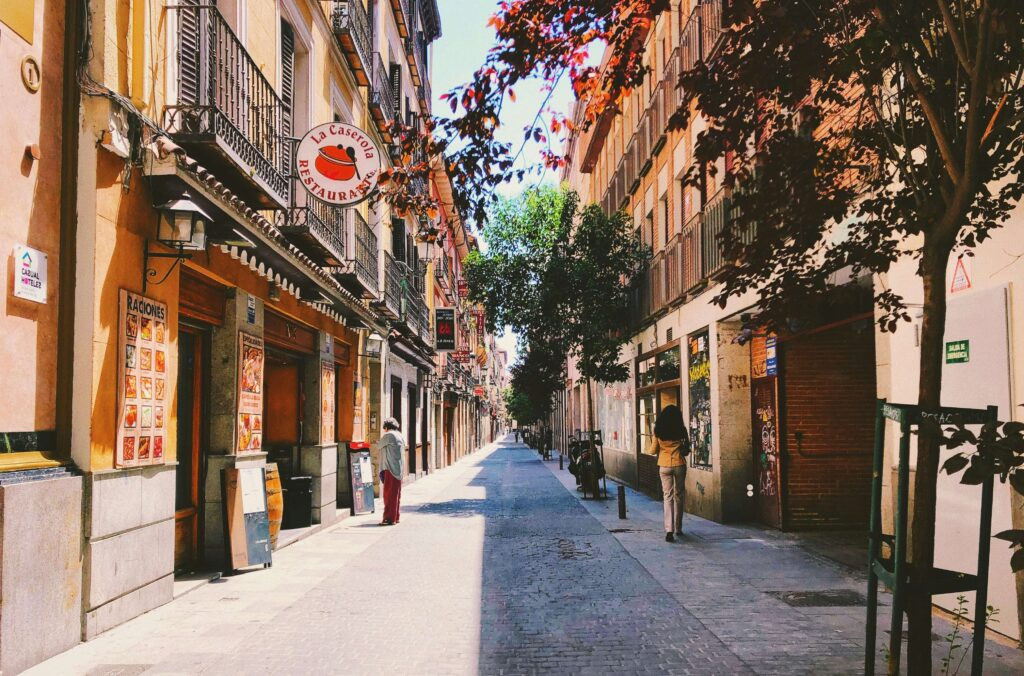
Urban Campus has five different living spaces in Madrid. (And some in Paris as well.) All of the locations are well-connected to the city center and have walkable neighborhoods.
All of the room options are private, and some of the buildings offer entire private apartments with kitchens. Unlike many colives, couples do not pay more for double occupancy—the room prices are set.
Most of their residents are professionals aged 25 and 40 from all over the world, who are freelancers, entrepreneurs, or people who work for companies remotely.
The buildings come on the larger side and have amenities like gyms, coworking spaces, and around 300 SQM of common areas. There are weekly events for residents to get to know one another and build community in the city.
Getting there: After flying into Madrid the Urban Campus colives can be reached by public transportation or rideshare.
Minimum stay: The minimum stay is one month, and it’s suggested to book at least a month in advance.
Internet: High-speed internet.
15. Node Coliving—Madrid
Node Coliving has three different coliving locations in Madrid, with another opening in 2025.
Two of the locations are Alcobendas and Carabanchel, both located a bit outside of the center, and well-connected by public transportation. Node has large modern buildings with high-quality amenities like gyms, pools, rooftop hangout areas, coworking spaces, and private meeting spaces.
The private apartments range from studios with kitchenettes to multiple bedrooms. Each room has a private workspace in addition to the shared coworking spaces.
They also have the Node Tetuan Boutique, which is a transformed warehouse located west of the city center in the Moncloa district. Shared spaces include a shared kitchen, industrial-style coworking space, and courtyards to hang out in.
Getting there: Upon flying into Madrid the Node colives can be reached by public transportation or rideshare. Madrid is also reachable by train or bus.
Minimum stay: Node’s prices are month to month. You can apply directly on the website.
Internet: High-speed internet all throughout the buildings and shared spaces.
16. Node Coliving Barcelona
Node also has a whopping nine different coliving locations in Barcelona. These one are in the style of more traditional flats rather than having a lot of shared common spaces like their Madrid locations.
There are five Node buildings in the neighborhood of L’Eixample alone, including Node La Predera, Node Tetuan, the brand new flats of Node Sagrada Familia, and Node Monumental Boutique, which has furnished apartments inside a 1925 building located in Eixample. The latter two are close la Sagrada Familia Cathedral, Ciutadella Park, and the technological hub of Poble Nou. Node Verdaguer is in a 1935 building and pays homage to a pioneer of Catalan literature named Jacinto Verdaguer.
In the heart of the city is Sant Antoni and the Gracia Boutique, also in historic buildings. Then there’s Node Parc Guell, which is of course in the Parc Guell neighborhood and has a bit of a bohemian flair. The Poble Sec location is in a historic 1936 building, split between the city center and Montjuïc.
Getting there: After flying into Barcelona the Node colives can be reached by public transportation or rideshare. Barcelona can also be reached by train or bus.
Minimum stay: Node is priced per month. Applications are accepted on the website.
Internet: High-speed internet all throughout the buildings and shared spaces.
17. Vivarium Coliving—Valencia
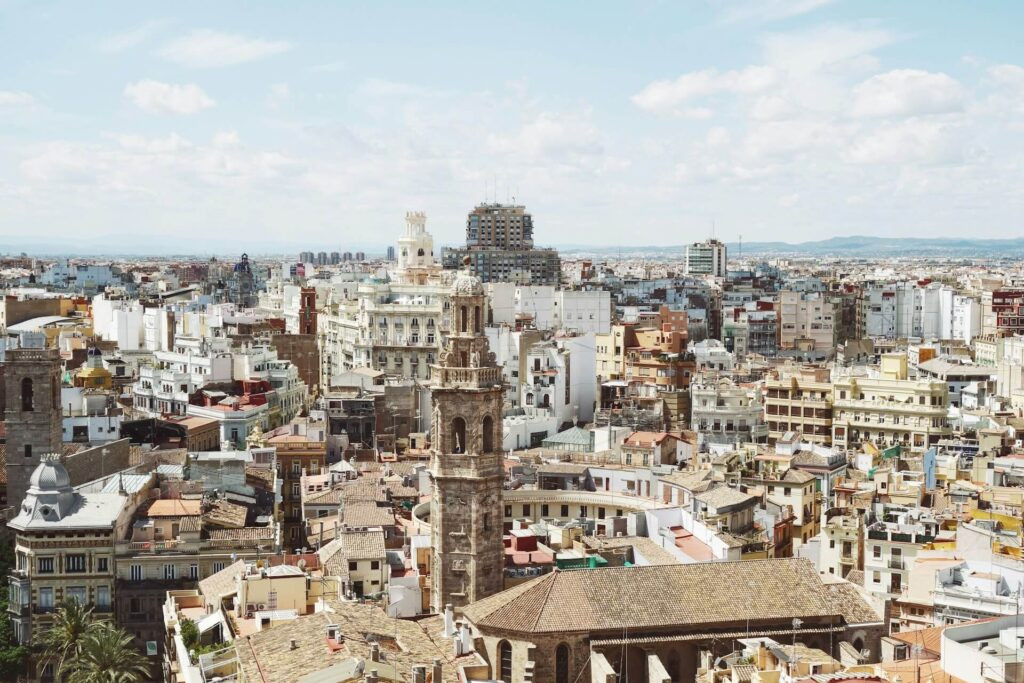
Vivarium is a coliving location in the heart of Valencia, which draws location-independent workers, entrepreneurs, artists, and nonconformists who are experimenting with a new way of living. The community has a focus on enacting change and takes part in projects and initiatives to benefit Valencia and beyond.
The building has three floors and 24 private rooms, each with their own private bathroom. Those rooms also contain desks, but there is an additional 100 square meters of professional work area, a library, private meeting rooms, terraces, and if you so desire, the living room table. On each floor of the building, there is a full kitchen where guests can come together or cook solo.
Additionally, weekly workshops are either held at the house and put on by a member, or something organized locally within the community. Guest ages range from 22 to 65 years old, with an average of 30.
Getting there: Vivarium is located in the neighborhood of Eixample, which can easily be accessed from Valencia Airport, which is 8 km/5 miles away from the city center.
Minimum stay: The minimum stays are one month, with most colivers staying at least two. Rooms tend to book out two months in advance.
Internet: Up to 1gb through ethernet cable.
18. Palma Coliving—Mallorca
Another great place to colive in Spain is Mallorca. Palma Coliving has two different locations there, Gomila and Villa Armadans.
Palma properties have both private and shared room options with desk space and ensuites. Some of the locations have rooms with private balconies and rooms that open up to the pool deck.
For working there are hot desks with ergonomic chairs, and other shared spaces include pools, private terraces, rooftops, jacuzzis, kitchens, and other living spaces. Group activities may include meditation sessions, networking events, tapas nights, hikes, and more.
Most of the guests are young professionals between the ages of 25 to 45 years old, with an average age of 33.
Getting there: From the airport in Mallorca it’s possible to take a taxi or catch a bus and get off at a nearby stop.
Minimum stay: The minimum stay varies by locations but is generally 14 nights or one month. Discounts may be available on stays that over a month.
Internet: Optic fiber high-speed wifi.
19. Palma Coliving—Barcelona
Palma’s Barcelona location is called La Casa de Turull and is located in a residential neighborhood called El Coll. (The city center is about 10 minutes away.) The house is next to Park Güell, a popular spot to check out the architectural work of Gaudí.
The room options include a private double room, primary bedroom, or standalone house, with ten to fifteen residents staying each month.
The Catalan Villa has a large private yard with a pool, garden, and BBQs. Like all Palma locations, there is a dedicated workspace with ergonomic chairs and organized group activities, making these properties popular choices for coliving in Spain.
Getting there: La Casa de Turull is about a 15-minute taxi ride from the airport or an hour via public transportation.
Minimum stay: One month.
Internet: Optic fiber high-speed wifi.
20. Palma Coliving—Valencia
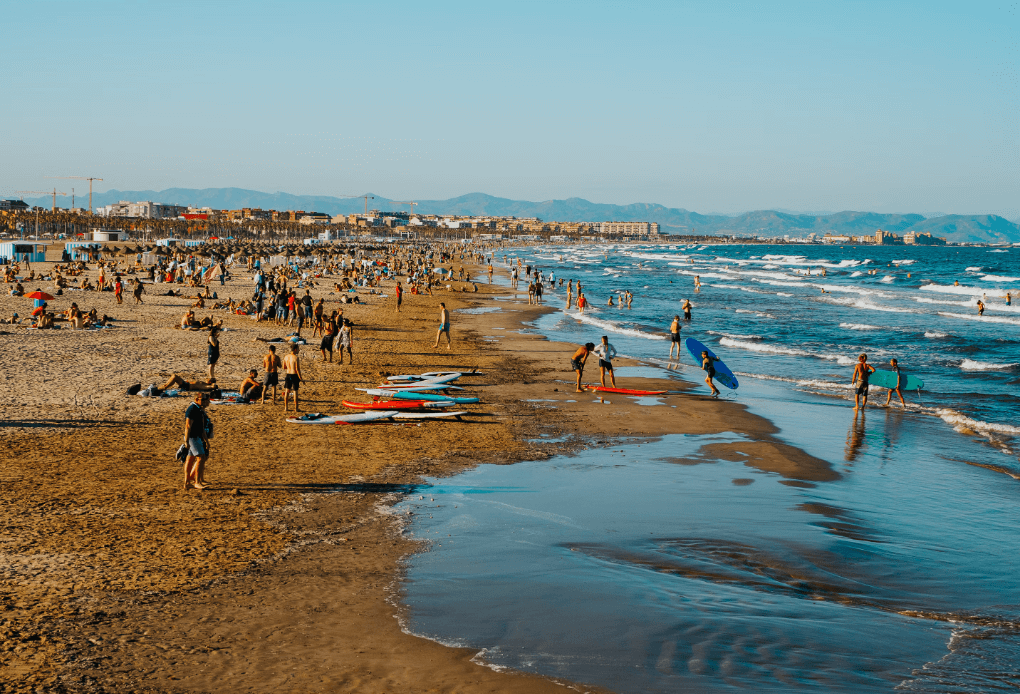
Palma Coliving’s Valencia location is a 500-year-old house called Villa Huerta. The home has ten bedrooms and welcomes up to fifteen guests at a time. Options include a private single, private double, or private double ensuite.
There are desks within the private rooms, as well as shared common areas throughout the house. The property is just a short bike ride to the beach, yoga studios, and gyms, supermarkets, and parks. There are also multiple arts areas in Valencia which are also not far on bike.
Getting there: The house is a 25-minute taxi or rideshare ride from the airport, or about 70 minutes taking public transportation.
Minimum stay: One month.
Internet: Optic fiber high-speed wifi.
21. Anceu Coliving—Galicia, northern Spain
For a more rural immersion coliving in Spain, Anceu is a great option. This property is located in Galicia and intends to leave a positive impact on the local village. Their slogan is “Think globally, act locally, revive rural.”
Some of their projects have included biodiversity actions to help the local ecosystem, working for the revitalization of rural areas through photography, and providing a platform for both local and international people to learn different aspects of technology, art, and culture.
The room options include a three-bed ensuite, double ensuite, single ensuite, and a detached apartment. As for the common areas, those include a 24/7 coworking office space, a kitchen, both indoor and outdoor meal space, a pool, and a patio. Groceries can be ordered to Anceu online.
If you feel passionate about making an impact you might also apply to their Rural Hackers residential program. Chosen participants will get free accommodation for a month and support to enact an idea they’d like to develop.
Getting there: Galicia has three international airports, Lavacolla Airport in Santiago de Compostela, Alvedro Airport in A Coruna, and Peinador Airport in Vigo. From the airport you can get to Anceu by bus, rental car, or taxi.
Minimum stay: One month.
Internet: 1Gb fiber optic internet.
22. Cowork and Surf—Various locations
Cowork and Surf is a community of 3,500 digital nomads with coliving properties all over the place. In Spain alone, there are multiple locations in Las Palmas, Gran Canaria, Tenerife, Galicia, and Lanzarote.
Each of the properties is slightly different, but all of them are homes with coworking space and coliving amenities. Some offer both private and shared room options, and some have coworking spaces in separate buildings. Naturally, they’re all located within close proximity of a beach!
Getting there: Varies by location.
Minimum stay: Varies by location but may be 7 nights or more.
Internet: High-speed internet.
23. iSlow Coliving—Laxe, Galicia
iSlow Coliving was created with a belief in living a life centered on community and traditions. The home was built in 1915 and belonged to iSlow founder Inés’s great-grandfather. It is located close to the town of Laxe, which is known to be a lively one in the area of Costa da Morte, in A Coruña, Galicia.
The coliving home hosts international digital nomads and local entrepreneurs who want a space to work and connect. There are private single rooms, double rooms, and shared rooms with desks, AC, and heating.
The property has both indoor and outdoor workspaces, private rooms for video calls, a kitchen, a garden, and a vegetable patch. It’s close to the beach and hiking area for plenty of outdoor activities during your stay.
It’s also a unique spot for coliving in Spain in that it’s family-friendly. Children have their own space on the property where they can play and be looked after.
Getting there: Galicia has three airports, Lavacolla Airport in Santiago de Compostela, Alvedro Airport in A Coruña, and Peinador Airport in Vigo.
Minimum stay: Two weeks during high season and one week during low season. Discounts are available for long-term stays.
Internet: 600 Mbps Wi-Fi connection.
24. Pitaya Coliving—Arrecife, Lanzarote

Pitaya is the first coliving on the island of Lanzarote. The location is in a great area of Arrecife called El Charco de San Ginés.
They have nine rooms on the property that can be shared or booked solo. There is 24/7 access to coworking space within the home, which has both sitting and standing desks—plus sea views to boot.
Other shared spaces include the kitchen and living room. They host yoga classes each week and even a Pitaya Festival for connecting over well-being, gastronomy, crafts, and music.
Getting there: You can fly to Lanzarote from Tenerife and Gran Canaria, as well as by ferry from Fuerteventura and Gran Canaria.
Minimum stay: One week, with discounts for stay over 28 nights.
Internet: 300 mb high-speed internet.
25. Allegory Coliving Experience—Seville

Allegory Coliving is located in the main area of Seville, and hosts professionals, entrepreneurs, and freelancers from all over the world who value coliving in Spain.
They offer both single and shared rooms, the latter being offered in arrangements of two or four beds. The shared spaces include coworking areas, a kitchen, a game room, and a rooftop terrace.
Getting there: Flying directly into Seville makes for easy access to Allegory. Other airport options would be Jerez, Malaga, Faro, and Tangier.
Minimum stay: One month.
Internet: There is WiFi throughout the building.
I hope this list of locations for coliving in Spain is helpful in your hunt! Let me know if there’s a destination I should add or an area you’d like to know more about.


